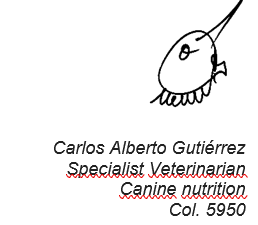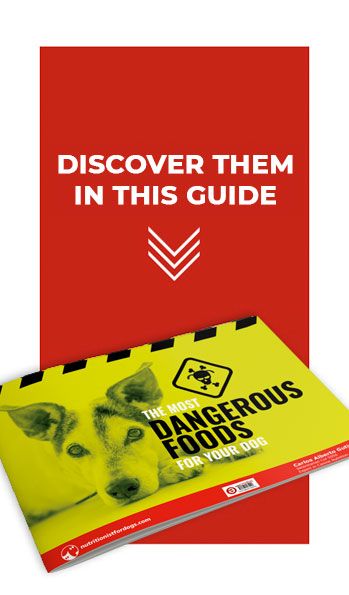
What is the best protein for my dog and how much protein should I give him? These are questions that I am asked frequently.
I am going to talk to you about two proteins that you almost certainly give your dog which are not good for him at all.
First let me give you some context and tell you a bit about what proteins are.
I always ask people whether they believe that their dog would survive on a diet consisting exclusively of fat.
Most people correctly answer no.
Do you think your dog would survive on a diet of exclusively carbohydrates? There are usually more doubts about this, but those who say no are correct.
Now, do you think your dog would survive on a protein-only diet? Most people say no.
WELL YES, it is possible; this is the only one of the 3 nutritional groups (proteins, carbohydrates and fats) that provide energy, and can support life with exclusively protein intake, and in the absence of the other two.
Of course, it would result in a poor quality of life, but it is possible due to synthesis or de novo pathway, which, in practical terms, means that the protein has the ability to act not only directly as a protein but also to be transformed into fat or carbohydrate, while the latter two are NOT capable of transforming into protein.
The “building blocks” of living organisms, at least animals, whether they be viviparous, where embryonic development takes place inside the mother’s body, such as in most mammals, or oviparous, where fertilization takes place internally after which the mother lays eggs, are essentially made up of proteins, which is why the term “building blocks” is so illustrative.
Arteries, veins, brain, liver, tendons, bones… EVERYTHING is constituted, to a greater or lesser degree, by proteins.
Why is ANIMAL protein so important and the best type of protein?
Because it contains ALL the ESSENTIAL amino acids, that is, those necessary for life to be possible.
Unfortunately, most of the commercial feeds (kibble) are made based on vegetable protein because it is much cheaper, because by including it, the protein level rises and you say: “Look, this food has a good level of protein”.
Remember that canines in the wild and carnivores in general, consume 10-15% carbohydrates, Commercial feed generally contains a whopping 45-75% of carbohydrates!
This is for economic reasons, not for the welfare of your dog; it’s as simple as that.
But, even if a feed (kibble) had no carbohydrates (grain free), or you were using the best feed in the world, a piece of chicken, fish, beef, rice, apple, etc. has HUGELY SUPERIOR NUTRITIONAL VALUE. Use a bit of common sense!
Returning to vegetable and animal protein. I was telling you that most feedstuffs contain 45 to 75% carbohydrates. What are these carbohydrates present in industrialized feedstuffs? CORN and SOYBEAN, and to a lesser degree, wheat and rice. Take a look at the packet of dried pellets you give to your dog so that you can open your eyes once and for all.
WHAT IS THE PROBLEM WITH CORN AND SOYBEANS?
These are the main proteins which this article is referring. I put it in capital letters because this is VERY IMPORTANT.
I would never recommend feeding a dog or cat based solely on these cereals.
If you occasionally give them kibble mixed in with some of your leftovers and they contain these grains or legumes, that’s fine, but it should not form the main basis of their diet, which is what you do when you give them those little dry balls that never go bad, DAY and NIGHT, which are based on… well, you’ve already seen it, right?
If it is already bad to feed your dog based on these foods day in, day out, think about the high probability that that corn is GMO, that is, genetically modified organisms. Did you think it was certified organic corn?
You may not know it, but one of the main questions in my clinic is food allergies. Often, these allergies are caused by proteins, many of them present in gluten (wheat), as well as the proteins present in corn and soy.
SOY AND ESTROGENS
I was telling you that one of my main consultations is food allergy. What are the others? Hepatic, renal, calculi, cancer, as well as obesity.
As you can see all these diseases are closely related to nutrition, I would remind you that more than 95% of pets at home are fed those dry, highly industrialized, non-perishable pellets.
It is well known that soy is rich in estrogens. Feeding your dog with industrialized food rich in soy causes an excess of estrogens in their body, resulting in cancer, thyroid diseases, Cushing’s syndrome, etc.
A large pet food company conducted a study several years ago examining how the type of protein used to feed an adult dog and an elderly dog affected their body composition (muscle vs. fat). The dogs were fed different amounts of protein such as chicken and corn gluten meal.
The results are overwhelming, as you will see them in the second part.
Bibliography
Swanson, K. S., Kuzmuk, K. N., Schook, L. B., & Fahey, G. C. (2004). Diet affects nutrient digestibility, hematology, and serum chemistry of senior and weaning dogs. Journal of Animal Science, 82(6), 1713–1724. https://doi.org/10.2527/2004.8261713x
Wakshlag, J. J., Barr, S. C., Ordway, G. A., Kallfelz, F. A., Flaherty, C. E., Christensen, B. W., … Davenport, G. M. (2003). Effect of dietary protein on lean body wasting in dogs: correlation between loss of lean mass and markers of proteasome-dependent proteolysis. Journal of Animal Physiology and Animal Nutrition, 87(11–12), 408–420.
Remember, love your dog, feed it with feed or croquettes, in addition to being mistreated, it is terrible nutrition, give it natural food made by you, for this you have the articles that we have published on the blog to learn.
Click here and fill out the questionnaire so that we can start working together.
Regards


